Adventure
 'I believe any trip in search of wildlife can be coupled with physical activity and elements of cultural diversity to form a thrilling opportunity ' 'I believe any trip in search of wildlife can be coupled with physical activity and elements of cultural diversity to form a thrilling opportunity '
John H.Eickert |
Bright almost shiny leaves, and waxy cream colored flowers whose blooms can spread wider than the width of a human hand, magnolia trees are common in upland riparian areas of the Greater Himal. Magnolias can grow to ten meters and bloom
at about the same time as rhododendrons. This is also a great time to trek. One of the best places to trek in the spring is Darjeeling . The long trek out of Darjeeling to Singalila ridge was discussed briefly in a previous article. When going to Darjeeling
it is possible to add two mini adventures to any visit. One of these is the “toy train” from New Jalpaiguri to Darjeeling . The other is the short trek to Tiger Hill.
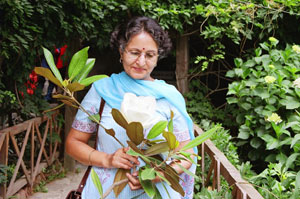
Darjeeling is famous for it's tea. Legend suggests tea growing originated in India more than five thousand years ago. Indeed, tea is consumed around the world and India the largest producer. About one quarter of that production is from
the Darjeeling area. Though Assam produces more tea, production in India is associated with Darjeeling . And, this has everything to do with the railroad. In the early days of the East India Company the rail terminus was at Darjeeling connecting with Calcutta
and the international tea brokerages there. The train trip takes about twelve hours as the train moves slowly, climbing up through the hillside. The views from the train, out across the plain toward Batasia can be spectacular. The train stops briefly at Ghoom,
a small town that claims to be one of the highest rail stations in the world. Overall, this is a novel way to approach Darjeeling and is well worth the small additional effort. It is fun to ride along and dream of what the countryside must have been like in
the late nineteenth century. The hope. The energy. There must have been elephants everywhere. Of course, the elephants are only a rare visitor and many of the tea plantations are in decline making it all the more important to touch the past while it is still
possible.
Despite the tea plantations, the magnolia have done better than the elephants. Tiger Hill, there hasn't been a resident tiger here for a long time, is a short trek with interesting views, and, in the spring, a chance to walk among the
flowering magnolias. The magnolias, which have become famous in such American cities as Atlanta and Charleston , are derived from the very same magnolias along the track to the summit of Tiger Hill.
In the modern world, there is such little time or focus to consider the past or the things around us. In Darjeeling , elephant sheltering magnolia trees gave way with the help of a dramatic railway to tea plantations and became the world
renown home of “ Darjeeling black.” Next month we will take a closer look at the long trek to Singalila ridge, perhaps some will undertake that trek this fall. Until then, take the time and when you do take your time. Cheers.
( Photograph of lady admiring Magnolia flower at Naggar, Himachal Pradesh: Susan Sharma)
Visit http://www.numbum.net or call NumBum Adventurers at 406-777-2228
|
Answers To Quiz Of The Month
This month bmahala@yahoo.com and
merv@rediffmail.com have given all right answers
Right Answer toQuiz on Bears
|
| 1.To which animal is the bear closely related? |
|
| 2.The Polar bear’s scientific name isursus maritimas. What does that mean? |
|
white bear |
ice bear |
sea bear
|
|
| 3.Which of the following animal is not a bear |
|
sloth bear |
giant panda |
red panda
|
|
| 4.Genetically the polar bear is most closely related to |
|
Asiatic brown bear |
Sun Bear |
Brown bear
|
|
| 5.Grizzly bears are actually the same as brown bears and both share the Greek name ursus arctos. They got the name grizzly from, |
|
a series of grizzly murders involving these bears near Seattle in the 1950s |
the silvery appearance of their coat when they grow old |
the ancient weather beaten appearance of their bodies
|
|
| 6.Bears walk in a ‘plantigrade’ fashion- that means |
|
they walk with very bowed legs |
they walk faster uphill than downhill |
they walk with their toes and heels touching the ground at the same time ( similar to human walk)
|
|
| 7.The spectacled bear lives only in |
|
North America |
South America |
Australia
|
|
| 8.This species of bear is found in India, Nepal, Bhutan and SriLanka |
|
Black bear |
Sloth bear |
Brown bear
|
|
| 9.When less than a year old, bear cubs have ropes or chains forced through their noses and most o their teeth are removed |
|
The `Madaris` of India do this to make them dance |
The Russians do this to train them for circus |
The Chinese do this to milk bile.
|
|
| 10.When do Giant pandas hibernate? |
|
Summer |
Winter |
They do not hibernate
|
|
Please try this month quiz onblack bucks
|
Burning Issues
By Shivani Thakur
A British commander in 1860 dreamt of a project-The Sethusamudram Canal Project. The construction of this canal was to cut short travel time between the east and west coast of India ; linking Gulf of Mannar and Palk Strait by more than
20 hours. This dream is being turned into reality but at the cost of environment. The canal to be constructed is around 260km long and 300m wide; through Adams Bridge . Currently the ships have to circumnavigate Srilanka to reach the east coast, which means
an extra day of travel and more fuel consumption. The Environment Ministry has given a go ahead. It now awaits approval of Union Cabinet.
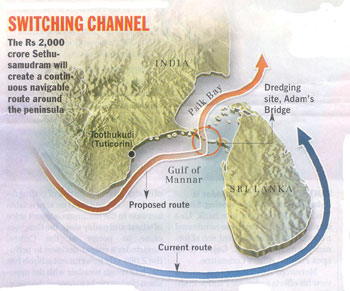
But this project has come under scrutiny. There is a lot of opposition from eco groups and fishermen. Fishermen feel that many rare export varieties of fish will move away Adams Bridge and reduce their inadequate fishing area. The Bridge
also acts as check dam. The environment effect this re-routing would result in major changes in the biodiversity of Gulf of Mannar . The Gulf is home to endangered marine species including sea horses, pipe fish, sea cows and coral. The route will pass about
20 km away from Shingle Island and 6km from VanTivu Island , both, which are part of Gulf of Mannar Marine National Park . There is a proposal that a buffer zone of 25 km around national parks should be created. The damage to coral reefs can cause high sea
tides. Once the canal is built there would be movement of fish from Bay of Bengal to Indian Ocean , which could prove dangerous to the eco-system. Any oil spill in this region would mean the pollutants could reach the coast.
Besides the environmental impact, there are many technical as well as economic aspects being overlooked. A thorough study has to be done of the currents and changes in the ocean floor to avoid any damage to the canal by violent currents.
The canal is being compared to the Suez Canal of the east. Whereas Suez Canal was constructed by cutting land, this is being done by dredging a strait. Its economic viability is also being questioned. The canal once built would allow ships of capacity of 30,000
tonne only. They would have to slow down to navigate through the narrow canal. This would in turn mean more time wastage as well as fuel consumption. Besides, modern ships are of over 100,000 tonne capacity. Therefore the project is no longer feasible.
The economic viability to environment impact, this project to cut through a natural chain of shoals raises a lot of questions. We quote a news item, which appeared in the Hindu.
“The Rs 2000 crore project will be viable only if the Sethusamudram Ship Canal (SSC) is a free seaway. The coal / oil ships, to avoid collision, would have to pass through canal under regulated pilotage and pushed/ pulled by tugs belonging
to the SSCP. The ships passing by would be expected to pay the SSCP for using the facility. Although the official reports say that the investment of Rs 2000 crore would be recovered with 9 % interest within 25 years after which it will bring mammoth profit.
The question arises: will the saving in fuel cost be substantially greater than charge to be levied by the SSCP to enthuse ship-owners to use the canal? If the SSCP is to make profit its levy must leave a margin after meeting the cost
of amortization of capital and the annual revenue expenditure incurred on maintenance dredging and provision of the pilotage services.
If the Chennai rate is assumed, the same ship will have to pay over Rs 60 lakhs to use the Sethusamudram Canal . But the cost of fuel saved by same ship to take the shorter route will be less than Rs 7 lakh. The saving time will be less
than 36 hours because the ship cannot be towed at normal speed. Time will also be lost in embarkation /disembarkation of pilots and other inspection procedures. The saving time of a day will not justify over 8 times the cost of fuel saved.
Thus, the Sethusamudram canal will save money and the SSCP will be financially viable are mutually contradictory. It cannot be compared to Suez Canal because the 160 km long Suez Canal saves a distance of 9000 km between a European port
and any other eastern port such as Colombo, Chennai, Singapore and consequent saving in fuel cost and time is substantial enough for ships to grudgingly pay the toll charges levied by Suez Canal Authority.
-K.S.Ramakrishnan, a former Deputy Chairman of Chennai Port Trust and former Managing Director Of Poompuhar Shipping Corporation, in the Hindu Open Page dated Dec.20, 2004
( Picture: Courtesy India Today May 16, 2005 )
|
Common Birds of India
By - Ragoo Rao
A proven hanger-on of man, whether in a busy urban locality, hilly area or the plains, this Ashy grey bird about six inches long was a very familiar bird until a decade and a half ago. It is inseparable from human habitation and hence
the Latin name-Passer domesticus.
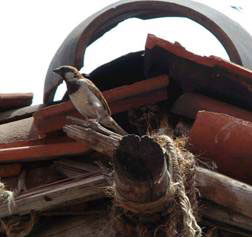 The males are slightly darker rufus colored around the head and wings, with a grayish patch below the beak. Females are ashy brown with streaks of black on the wings and upper body. These birds are omnivorous, eating grains and insects
alike with relish. Sometimes they come to the kitchen window sills also in search of grains or cooked rice. They literally stay around in compounds and roost in shrubs in the compounds. Their favourite plants for roosting being medium Pomegranate trees or
Bougainvillea. The males are slightly darker rufus colored around the head and wings, with a grayish patch below the beak. Females are ashy brown with streaks of black on the wings and upper body. These birds are omnivorous, eating grains and insects
alike with relish. Sometimes they come to the kitchen window sills also in search of grains or cooked rice. They literally stay around in compounds and roost in shrubs in the compounds. Their favourite plants for roosting being medium Pomegranate trees or
Bougainvillea.
They create a noisy chirping in the twilight until the roosting order is settled. The males are easily heard with their characteristic- chi-chi-chi and chrrr-chrrr-chrrrr. The breeding males sing a loud monotonous tsi-tsi-tsi, with their
feathers ruffled up and hopping closer to the enticed female. Breeding season is practically year round. Their favourite nesting sites could be under the rafters in tiled houses, behind photo-frames hung inside the houses, a niche under the tiled roofs. The
nest is made up of feathers, dried grass, straw and rubbish. Three to five pale greenish eggs with brown blotches are laid in the nests. Both the parents share all domestic chores. The young hatchlings are exclusively raised on insect larvae and insects. Several
successive broods are raised in the same nest. One can see the fledglings, after they come out of the nests, still hanging on to their parents begging for food with a shrill chi-chi- chi-chi and pestering the parents.
Unfortunately, this once common bird is becoming a rare sight in urban localities owing to several reasons. All these reasons for their becoming rare are the contributions of Man.
The observations which I have made, in my opinion, can be summarized into these main factors:
• Loss of foraging grounds in urban areas.
• Loss of nesting sites.
• Loss of insect population to bring up a brood.
• Loss of roosting shrubs.
In effect, a total loss of habitat in urban areas.
The encouraging thing is one can still find the much loved House sparrow in the rural hamlets and also in the urban areas in isolated pockets where the environment is still congenial to them in their basic requirements.
(Photo of male sparrow near nest: Ragoo Rao)
A Field study of the House Sparrow.
|
General
- S.Ananthanarayanan
Scientists studying the recent outbreak of fungus infection in teak trees in the Khandwa region, Madhya Pradesh have said that a variety of species need to planted, to make sure that teak saplings get the correct nutrition.
How could planting competitors for nutrition help the teak saplings?
The prescription, in fact, was not to have more trees competing, but to have more kind of trees. Having more species would mean less teak trees ion all and the nutrition drawn by each teak tree would then be almost the same. But more
species would help maintain the balance of nutritional components and promote healthy trees all round, teak included.
Sitting duck for parasites
A specialized bio-system, like a plantation of only teak, is a sitting duck for parasites. A natural forest is thus never of just teak, but has the diversity of mutually supporting species, co-operating both against predators as well
as in sustaining the nutritional viability of the land.
A parasite that selectively attacks teak would find the presence of other species an impediment to undisturbed multiplication. Similarly, the teak would protect the other species against parasites that threaten those species. If one
species increased out of proportion, these very parasites would get active and keep down the population of the runaway species. Just as reduction of population of a species would lead to the parasites having a harder time, to live or to find trees to harm,
and the population would rise again.
The mix of species in a natural forest is in continuous adjustment for optimum survival of the mutually co-operating species. Naturally occurring, wild strains of cereal and other food plants are thus likely to survive ups and downs
of climate or inroads of pests or infections. A cultivated strain, specialized through farming, on the other hand, has scant defense against a sudden epidemic or mishap, with the use of fertilizers or insecticides. This is an important reason to make sure
that sufficient acreage of wild and natural vegetation be allowed to survive. This would be the reserve to draw on, to develop specialisd strains again, if the current ones were to be wiped out.
More species ensure balance
In the matter of nutrition also, the same symbiotic protection becomes effective. If a plantation consists largely of a species that draws more of particular nutrients from the ground, those nutrients are likely to be depleted, in time.
But if there is a variety of species, then the mix of nutrients drawn would stabilize after some time. And the mechanisms that replace the nutrients, like nitrogen fixation, seepage, bacterial action, etc., can keep the level of nutrients adequate for the
different, dependant species. Again, if one species increased in number, the particular nutrients it used most would begin to reduce and the growth of the species would slow down. The mix of species in the forest would thus remain stable so long as conditions
like rainfall, sunlight, soil quality remain unchanged.
Simply having a forest with less trees, but of a particular kind would not serve, either. It is still necessary to have diverse species. Having less trees of just one species would result in specific nutrient components being
drawn out. Over time, the land would contain a smaller and smaller component of those nutrients, and the land would be unable to support even the sparse population of the species that needs that component. Having other species present would result in other
nutrient components being drawn out as well and this would maintain the chemical balance of the soil.
This is why all species thrive in highly diverse plantations like rain forests or thick natural collections of plants.
[The writer can be contacted at: simplescience@gmail.com]
|
News and Views
News.............
IndianWildlifeClub.com took shape from the belief that environmental and conservation issues can be solved only when the common man is involved-involved on a daily basis, seized of the matter in all that he does. Wildlife
Scientists, Forest Officers and Naturalists have their hands full. Can the common man pitch in? Certainly. To prove this point, we have revamped our “ Club Chapters” on the homepage, This page will now feature field studies and practical suggestions by IWC
members who are seized of the problem. That we have a major problem moving away from nature is now accepted by all thinking persons. So write in. Your suggestions can form part of our think tank.
Bird lovers have been worried about the disappearance of the chirpy sparrows from urban areas; a plantation consultant decided to make some careful observations.
Click here to read about a field study of sparrows in Mysore .
Read a proposal submitted by a Railway officer to save the narrow gauge in Jabalpur and thereby save disturbance to two major National Parks in Madhya Pradesh. It is this kind of holistic thinking on the part of our decision
makers that can help nature and wildlife.
Click here to read this proposal.
Even as this ezine is uploaded, the dredging for the Sethu Samudram Canal is about to start. We have an article on the subject which helps understand the issues involved better.
Click here to read it.
The trek through Kawal Sanctuary continues. The trekkers are now more involved- asking questions of the villagers at Udhampur to understand their mindset.
....................and Views.
"We have to change our idea of water because there isn't enough water for everything. This is the reality and it should be apparent to any one with any intelligence.”
“What's important for Spain , as a country, is to accept droughts as a normal occurrence, not a punishment from God or a biblical plague. It's simply a condition of our environment and this ought to encourage us to manage
and live with it. Droughts are part of our culture. Anticipation and prevention are the two recipes."
-Jaime Pallop, director of the Spanish Environment Ministry's Water Department.
"To get wood we don't have to destroy the forest but rather look after it. It's the same with water; We must recuperate our rivers and aquifers. That's the new culture of water- sustainable and prudential."
-Pedro Arrojo, whose work in water conservation won him San Francisco 's prestigious Goldman environmental prize in 1999.
(Quoted in the Associated Press)
|
Story Of The Month
(Contd. From last ezine)
- Saraswati Kavula
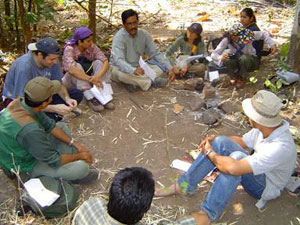 While going through the village of Udhampur , we stopped at a bore pump to drink some water. I noticed cotton fields and inquired about the crop, they did not get a good crop this time. “we had a lot of pest, although we used monochrotophos
and endosulphan', one of the villagers replied. Both pesticides have been banned abroad, but sold extensively in all villages in Andhra. The villagers do not know the facts about the pesticides and simply trust the shopkeeper for advice on the pesticides.
I did not have much time to discuss the issue with the people there. While going through the village of Udhampur , we stopped at a bore pump to drink some water. I noticed cotton fields and inquired about the crop, they did not get a good crop this time. “we had a lot of pest, although we used monochrotophos
and endosulphan', one of the villagers replied. Both pesticides have been banned abroad, but sold extensively in all villages in Andhra. The villagers do not know the facts about the pesticides and simply trust the shopkeeper for advice on the pesticides.
I did not have much time to discuss the issue with the people there.
We went to the main road, thinking that if the jeep is not there, we could go by the local bus. So we waited at the village teashop, which also happens to be the main centre for the village. I asked the man to give me tea in a steel
glass. He was surprised. Then we discussed about the harmful effects of plastic. Our discussion veered towards the impact of plastics on forest. Some villagers gathered around us. I asked, ‘what is the situation in your village?' They said, ‘there is no water'.
I replied, ‘how can you find water if you continue to cut down the forest around you?' To which one man said, well, see people here are too poor, so what can they do except for cutting down the wood to make a living? Look at me, look at him, we all are broke',
he said pointing to one of his neighbours. Then an argument ensued. The neighbouring man to whom the first one pointed got angry, ‘who is a beggar? Speak for yourself. I work hard, and I earn good money, you spend all your time drinking and end up in debts,
I am a Maratha and I work hard!” the man retorted. I told the first guy, ‘he is right, the reason for our backwardness is also our lazy attitude, the Marathas and Punjabis prosper because they work hard.
The Maratha man spoke up, ‘see madam, this fellow is always drunk, who will give him work and how can he make money if he doesn't till his land?' I asked the first man, ‘do people drink here?' the first man said, ‘yes, we all drink gudumba,
but you must ask the gudumba man to stop selling gudumba!' I told him, ‘well as long as there are people like you who drink, they will always make it. First you must stop drinking', to which all except our drunken friend agreed and nodded. We would have continued
our discussion, but I was called out to join the others in the auto. Since, we waited a while and assumed that the jeep wasn't coming; we all filed into the auto rickshaw and started towards Jannaram. On our way, we came across a forest fire. And we all got
down to douse the flames and managed to put - off the fire. Linganna said, ‘someone did it on purpose'. The rest of the evening passed off uneventfully except for meeting Anwar ali the man
selling pan at Jannaram in front of the Udipi hotel. Swetha asked him where he was from, ‘I am also from Hyderabad , and I came here during the communal riots in the 80's. I have my relatives here, they asked me to come over here and
ever since I have been living here'. He was happy to see people from his home town and reduced the price of pan by fifty paisa.
The next day morning, we left at 6am in the jeep, to go to the machaan inside the tiger habitat. But before that we went towards gangapur village. We could only see some Sambhar and chinkaara, groups of them and of course some langoors
and lots of birds. About five to six kilometres from the village, we found a whole area of forest was cut down. It was a freshly cut forest and nearly 60-70 year old trees were chopped down. In the middle of the clearing, we found a wooden cross used by the
Gonds to represent their spirits. Surely, it was an encroachment of the forest. “this seems to be a fresh encroachment and it is not even close to the village, so it cannot be a podu land either', Imran said. Towards 8 o clock we reached Gangapur village.
It had some thirty five households and it was mix of backward castes and tribes as well. Almost all houses were made in the traditional fashion using teak beams and mud tiles. Some were brick wall and tile roof houses like the plain areas. There was a drilling
machine, drilling a bore well. Some people were gathered around that place. One of them was the chairperson of the local Vana Samrakshana Samiti.
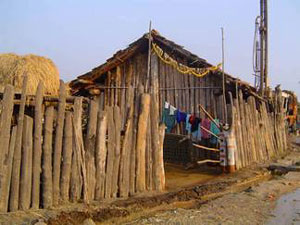 I asked him, “How many trees do you use to make one house.” That man answered sheepishly, “Big and small together about 40 to 50 trees'. Some discussion followed amongst villagers, “yes, about four to five big ones and twenty to
thirty small ones!' they replied. I asked him, “How often do you rebuild your house?” ‘Well one house lasts for about twenty years and then we make a new one!' And of course, when the son gets married, he makes his new house and so on and so forth. One of
the members asked the man, ‘if you cut down the forest at this rate, nothing will be left here, have you thought why you were not getting the water?” The villagers replied, “What can we do, we cannot afford to buy building material, so we cut the trees'. Then
the VSS chairman replied, “actually collector amma came here and then cancelled the funds for our VSS, she even warned us that if we cut down any trees, she will not allow us the quota of rice from the ration shops. What can we do amma, we need to have a roof
on the head as well isn't it?' So we replied, ‘ask the collector to make you pucca houses'. ‘Who had cleared the forest five kilometres from here?” we inquired. “The Gonds from Laxmipur which is two kilometres from here have done it', the villagers replied.
“Seems like people have started to encroach on fresh land, in the hope of the land distribution scheme of the Chief Minister', Imran remarked. I asked him, “How many trees do you use to make one house.” That man answered sheepishly, “Big and small together about 40 to 50 trees'. Some discussion followed amongst villagers, “yes, about four to five big ones and twenty to
thirty small ones!' they replied. I asked him, “How often do you rebuild your house?” ‘Well one house lasts for about twenty years and then we make a new one!' And of course, when the son gets married, he makes his new house and so on and so forth. One of
the members asked the man, ‘if you cut down the forest at this rate, nothing will be left here, have you thought why you were not getting the water?” The villagers replied, “What can we do, we cannot afford to buy building material, so we cut the trees'. Then
the VSS chairman replied, “actually collector amma came here and then cancelled the funds for our VSS, she even warned us that if we cut down any trees, she will not allow us the quota of rice from the ration shops. What can we do amma, we need to have a roof
on the head as well isn't it?' So we replied, ‘ask the collector to make you pucca houses'. ‘Who had cleared the forest five kilometres from here?” we inquired. “The Gonds from Laxmipur which is two kilometres from here have done it', the villagers replied.
“Seems like people have started to encroach on fresh land, in the hope of the land distribution scheme of the Chief Minister', Imran remarked.
(Photo credits: tribal hut-Saraswati Kavula, Trekking team-Akhil)
(To be concluded)
|